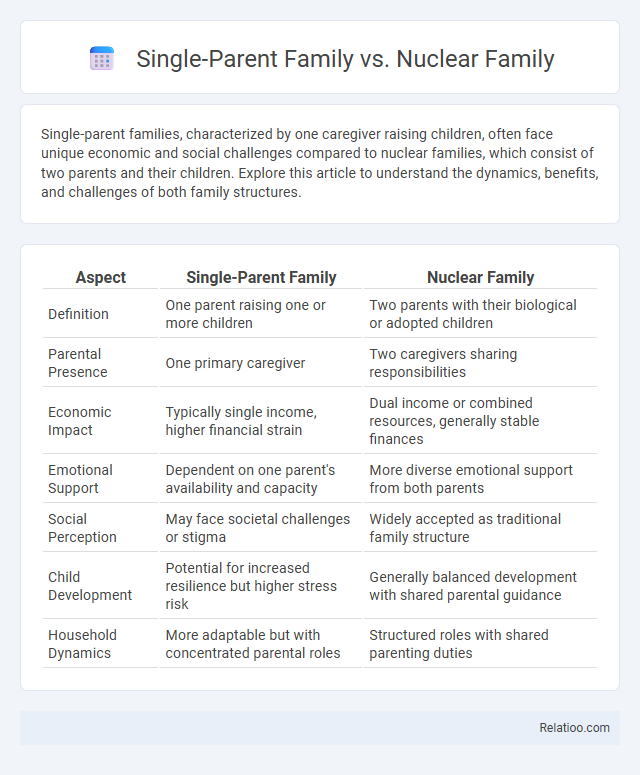Single-parent families, characterized by one caregiver raising children, often face unique economic and social challenges compared to nuclear families, which consist of two parents and their children. Explore this article to understand the dynamics, benefits, and challenges of both family structures.
Table of Comparison
| Aspect | Single-Parent Family | Nuclear Family |
|---|---|---|
| Definition | One parent raising one or more children | Two parents with their biological or adopted children |
| Parental Presence | One primary caregiver | Two caregivers sharing responsibilities |
| Economic Impact | Typically single income, higher financial strain | Dual income or combined resources, generally stable finances |
| Emotional Support | Dependent on one parent's availability and capacity | More diverse emotional support from both parents |
| Social Perception | May face societal challenges or stigma | Widely accepted as traditional family structure |
| Child Development | Potential for increased resilience but higher stress risk | Generally balanced development with shared parental guidance |
| Household Dynamics | More adaptable but with concentrated parental roles | Structured roles with shared parenting duties |
Understanding Single-Parent and Nuclear Families
Single-parent families consist of one adult raising one or more children, often facing unique economic and social challenges compared to nuclear families, which include two parents and their children living together. Understanding the dynamics of single-parent families involves recognizing factors such as parental workload, financial stability, and child development impacts, while nuclear families benefit from shared responsibilities and combined resources. Research highlights that both family structures influence children's emotional well-being and socialization, with stability and parental involvement being key factors across both family types.
Historical Overview of Family Structures
Nuclear families, characterized by two parents and their children, have been the dominant family structure since the Industrial Revolution, promoting economic stability and urban living. Single-parent families, often resulting from divorce, widowhood, or non-marital childbirth, became more prevalent in the late 20th century due to shifting social norms and increased female workforce participation. Extended single-parent families existed historically but were less recognized socially, with changes in legal and social policies over time influencing family dynamics and support systems.
Key Characteristics of Single-Parent Families
Single-parent families are characterized by one adult caregiver responsible for raising children, often managing both financial support and household duties alone, which can increase stress and limited resources. These families frequently face challenges such as reduced income and less social support compared to nuclear families, which consist of two parents sharing responsibilities. Your understanding of single-parent family dynamics highlights their resilience and the importance of targeted social programs to support their unique needs.
Key Characteristics of Nuclear Families
Nuclear families typically consist of two parents and their biological or adopted children, offering a stable structure for emotional and financial support. Key characteristics include a clear division of household roles, cohabitation under one roof, and shared responsibilities for child-rearing and decision-making. Your understanding of family dynamics can benefit from recognizing these distinct features compared to single-parent family setups, which involve only one caregiver managing all parental duties.
Emotional and Social Impacts on Children
Children in single-parent families often face challenges related to reduced emotional support and economic constraints, which can affect their social development and academic performance. Nuclear families typically provide a more stable environment with both parents contributing to emotional nurturing, fostering better social skills and resilience in children. However, the quality of parenting and family dynamics play a critical role in emotional and social outcomes, regardless of the family structure.
Financial Stability and Economic Challenges
Single-parent families often face greater financial instability compared to nuclear families due to a single income source, which can limit economic opportunities and increase vulnerability to poverty. Nuclear families typically benefit from dual incomes, enhancing financial resilience and providing a broader safety net for economic challenges. Your financial planning and support systems play a crucial role in mitigating risks, regardless of family structure, by addressing unique economic pressures and stability factors.
Parenting Roles and Responsibilities
Single-parent families require one caregiver to fulfill all parenting roles and responsibilities, including financial support, emotional nurturing, and daily child-rearing tasks, often leading to increased challenges and time management demands. In contrast, nuclear families, consisting of two parents, typically distribute parenting duties between both adults, allowing for shared responsibilities and collaborative decision-making in child development and household management. The dynamic in single-parent families emphasizes resilience and multitasking, while nuclear families benefit from dual support systems that can enhance stability and resource availability for children.
Support Systems and Community Resources
Single-parent families often rely heavily on community resources such as childcare assistance, financial aid programs, and support groups to manage their unique challenges and provide stability for children. Nuclear families typically benefit from shared parental responsibilities and can access broader social networks for emotional and practical support, reducing reliance on external community services. Community organizations and social services play a critical role in supplementing the support systems of both family types, promoting resilience and well-being through targeted programs and accessible resources.
Educational Outcomes in Different Family Types
Educational outcomes vary significantly among single-parent and nuclear families, with children in nuclear families generally achieving higher academic performance due to increased financial stability and parental involvement. Single-parent families often face challenges such as limited resources and time constraints, which can impact your child's educational support and extracurricular participation. However, positive outcomes are possible when single parents access supportive interventions and community resources that enhance learning opportunities.
Future Trends in Family Dynamics
Future trends in family dynamics indicate a rise in single-parent families due to increasing divorce rates and changing social norms, emphasizing diverse child-rearing practices. Nuclear families continue to adapt with dual-income households becoming standard, influencing work-life balance and gender roles. Advances in technology and shifting cultural values promote flexible family structures, challenging traditional definitions and fostering more inclusive support systems.

Infographic: Single-Parent Family vs Nuclear Family
 relatioo.com
relatioo.com